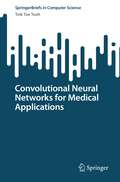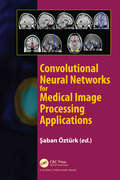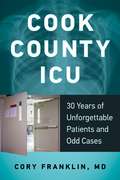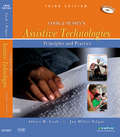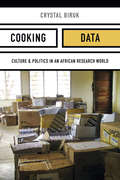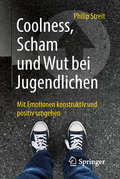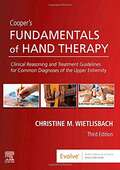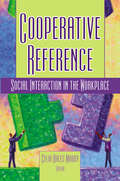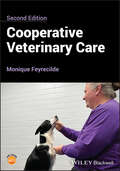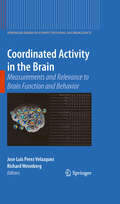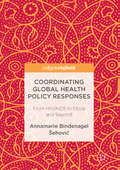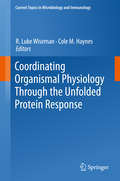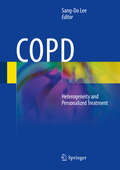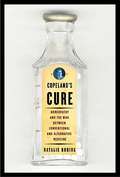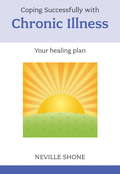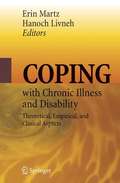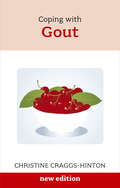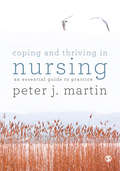- Table View
- List View
Convolutional Neural Networks for Medical Applications (SpringerBriefs in Computer Science)
by Teik Toe TeohConvolutional Neural Networks for Medical Applications consists of research investigated by the author, containing state-of-the-art knowledge, authored by Dr Teoh Teik Toe, in applying Convolutional Neural Networks (CNNs) to the medical imagery domain. This book will expose researchers to various applications and techniques applied with deep learning on medical images, as well as unique techniques to enhance the performance of these networks.Through the various chapters and topics covered, this book provides knowledge about the fundamentals of deep learning to a common reader while allowing a research scholar to identify some futuristic problem areas. The topics covered include brain tumor classification, pneumonia image classification, white blood cell classification, skin cancer classification and diabetic retinopathy detection. The first chapter will begin by introducing various topics used in training CNNs to help readers with common concepts covered across the book. Each chapter begins by providing information about the disease, its implications to the affected and how the use of CNNs can help to tackle issues faced in healthcare. Readers would be exposed to various performance enhancement techniques, which have been tried and tested successfully, such as specific data augmentations and image processing techniques utilized to improve the accuracy of the models.
Convolutional Neural Networks for Medical Image Processing Applications
by Şaban ÖztürkThe rise in living standards increases the expectation of people in almost every field. At the forefront is health. Over the past few centuries, there have been major developments in healthcare. Medical device technology and developments in artificial intelligence (AI) are among the most important ones. The improving technology and our ability to harness the technology effectively by means such as AI have led to unprecedented advances, resulting in early diagnosis of diseases. AI algorithms enable the fast and early evaluation of images from medical devices to maximize the benefits. While developments in the field of AI were quickly adapted to the field of health, in some cases this contributed to the formation of innovative artificial intelligence algorithms. Today, the most effective artificial intelligence method is accepted as deep learning. Convolutional neural network (CNN) architectures are deep learning algorithms used for image processing. This book contains applications of CNN methods. The content is quite extensive, including the application of different CNN methods to various medical image processing problems. Readers will be able to analyze the effects of CNN methods presented in the book in medical applications.
Cook County ICU: 30 Years of Unforgettable Patients and Odd Cases
by Cory FranklinAn inside look at one of the nation's most famous public hospitals, Cook County, as seen through the eyes of its longtime Director of Intensive Care, Dr. Cory Franklin. Filled with stories of strange medical cases and unforgettable patients culled from a thirty-year career in medicine, Cook County ICU offers readers a peek into the inner workings of a hospital. Author Dr. Cory Franklin, who headed the hospital’s intensive care unit from the 1970s through the 1990s, shares his most unique and bizarre experiences, including the deadly Chicago heat wave of 1995, treating some of the first AIDS patients in the country before the disease was diagnosed, the nurse with rare Munchausen syndrome, the first surviving ricin victim, and the famous professor whose Parkinson’s disease hid the effects of the wrong medication. Surprising, darkly humorous, heartwarming, and sometimes tragic, these stories provide a big-picture look at how the practice of medicine has changed over the years, making it an enjoyable read for patients, doctors, and anyone with an interest in medicine.
Cook and Hussey's Assistive Technologies: Principles and Practice
by Albert M. Cook Janice Miller PolgarMaster the assistive strategies you need to make confident clinical decisions and help improve the quality of life for people with disabilities with the latest edition of this comprehensive text. Based on the Human Activity Assistive Technology (HAAT) model developed by the authors, the book provides detailed coverage of the broad range of devices, services, and practices that comprise assistive technology and focuses on the relationship between the human user and the assisted activity within specific contexts. This title includes additional digital media when purchased in print format. For this digital book edition, media content may not be included
Cooking Data: Culture and Politics in an African Research World (Critical Global Health: Evidence, Efficacy, Ethnography)
by Crystal BirukIn Cooking Data Crystal Biruk offers an ethnographic account of research into the demographics of HIV and AIDS in Malawi to rethink the production of quantitative health data. While research practices are often understood within a clean/dirty binary, Biruk shows that data are never clean; rather, they are always “cooked” during their production and inevitably entangled with the lives of those who produce them. Examining how the relationships among fieldworkers, supervisors, respondents, and foreign demographers shape data, Biruk examines the ways in which units of information—such as survey questions and numbers written onto questionnaires by fieldworkers—acquire value as statistics that go on to shape national AIDS policy. Her approach illustrates how on-the-ground dynamics and research cultures mediate the production of global health statistics in ways that impact local economies and formulations of power and expertise.
Cooking for Health and Disease Prevention: From the Kitchen to the Clinic
by Nicole M. FarmerPoor diet and substandard nutrition are underlying causes of many diseases including cardiovascular disease, diabetes, and cancer. Collectively, these ailments are the leading causes of premature death, most of which are preventable. Cooking for Health and Disease Prevention: From the Kitchen to the Clinic helps demonstrate cooking as a fundamental bridge between ideal nutrition and long-term health. Clinicians, patients, and the public often lack adequate knowledge to help select and prepare foods for optimal disease management. This book provides information to clinicians and their patients about foods and cooking principles to help prevent common health conditions.Features: Focuses on disease endpoints, reviewing the disease biology and epidemiology and presenting dietary interventions for disease prevention. Provides recommendations for translating dietary and culinary principles of health prevention into clinical practice and includes a recipe appendix with practical examples. Features information on healthy cooking techniques as well as food selection, storage, and preparation to help maximize nutritional value. Introduces the reader to fundamental concepts in nutrition and culinary principles explaining the relationship between food processing and food preparation and nutritional quality of foods. This book is accessible to patients and offers evidence-based practical interventions for healthcare professionals. It is authored by Nicole Farmer, physician scientist at the NIH Clinical Center, and nutrition researcher Andres Ardisson Korat, awarded a doctorate degree in nutrition and epidemiology from the Harvard T.H. Chan School of Public Health.
Coolness, Scham und Wut bei Jugendlichen: Mit Emotionen Konstruktiv Und Positiv Umgehen
by Philip StreitGeborgenheit, Autonomie und Erfolg, das wünschen sich junge Menschen. In diesem Rahmen entwickeln sie Lösungsversuche, um sich diese grundlegenden psychologischen Bedürfnisse zu erfüllen. Sind diese nicht angemessen, reagiert die Umgebung oft mit abwertenden Reaktionen. Schnell entsteht bei den Jugendlichen Scham. Und: Es ist vor allem der Verlust der Würde, der es für sie so schwer macht. Philip Streit arbeitet seit über 20 Jahren mit jungen Menschen und mit deren Familien. In diesem Buch zeigt er Eltern und interessierten Laien, welche Kraft in Neuer Autorität und Positiver Psychologie steckt, damit Erwachsene respektvoll und präsent an Jugendliche herangehen können, und wie sie diese Scham für gelingende Beziehungen nützen können. Zahlreiche Fallbeispiele und Übungen erleichtern die Umsetzung im Alltag. Die Erfahrung zeigt: Wer das übt und ausprobiert, ist nicht nur von den günstigen Auswirkungen überrascht, sondern auch davon, wie leicht es gelingt.Geschrieben für … Eltern, interessierte Laien; Psychotherapeuten, Psychologen, Ärzte, Schulberater, Lehrer können mitlesen.Der AutorDr. Philip Streit leitet das Institut für Kind, Jugend und Familie in Graz, wo er als Klinischer Psychologe und Psychotherapeut mit Kindern, Jugendlichen und ihren Familien arbeitet. Er ist Autor verschiedener Bücher über Neue Autorität und Positive Psychologie im Alltag mit Kindern und Jugendlichen.
Cooper's Fundamentals Of Hand Therapy: Clinical Reasoning And Treatment Guidelines For Common Diagnoses Of The Upper Extremity
by Christine M. WietlisbachWritten for hand therapy specialists and non-specialists, Cooper's Fundamentals of Hand Therapy, 3rd Edition emphasizes treatment fundamentals, and provides tips and guidelines for hand therapy practice. This easy-to-use illustrated text and reference guide helps further develop your clinical reasoning skills by describing what goes into the evaluation process, highlighting the humanistic side of each encounter through case studies, and providing the wisdom the contributing authors have acquired through years of practice. This new edition also features additional chapters on the use of common physical agents and orthoses, plus added content on how to integrate evidence-based findings into daily hand practice.
Cooperative Reference: Social Interaction in the Workplace
by Linda S KatzExpert advice for more effective teamwork in the library! Cooperative Reference: Social Interaction in the Workplace addresses the need for reference librarians to work together to keep the system running smoothly. This book explores the various means of developing social professionalism, collaborating on projects, and combining forces with other libraries to remain on the cutting edge of information services in this new century. Using this guide, you will learn from the first-hand experiences of on-the-job reference librarians. This book will give you-as a reference librarian, administrator, library science student, or educator-ideas to support cooperative efforts in the library and beyond. This book will show you how to better interact with: other reference librarians face-to-face users online users library and academia faculty other libraries Cooperative Reference reveals how patrons perceive you from the other side of the desk. This book shows that first impressions-how you dress, your attitude, how you interact with other workers, and how you address the patron&’s questions-directly affect the patron&’s visit and influence his or her decisions about using your library in the future. The social skills in this volume can also directly benefit your library as library budgets can no longer keep up with the skyrocketing costs of library materials. To continue viability, many libraries must be willing to work together to share costs and experience. Other topics in Cooperative Reference include: tag-team referencing-a dynamic, synergistic environment at the reference desk teaching librarians about interpersonal skills-how to establish professional, collegial relationships with one another librarians teaming up to teach a class together cooperative reference desk scheduling-how to create and implement tailored desk hours collection development between librarians for different departments working together to create online services a consolidation of reference services by two separate libraries Using several case examples, this well-referenced book takes an innovative look at the ever-increasing necessity for librarians to work together for the good of the patrons, the workers, and the library structure. Cooperative Reference will improve the reference services of public and academic libraries both large and small.
Cooperative Veterinary Care
by Alicea Howell Monique FeyrecildeCooperative Veterinary Care puts the focus on preventing and reversing fear and stress in the veterinary setting through preparation, planning, and most importantly training. Offers evidence-based cooperative techniques to prevent fear and calm reactive patients, with concrete guidance for preventing, identifying, and reversing fear and stress in the veterinary setting Provides a unique system for identifying patients and selecting the right technique for each pet Supplies information on safe patient exams and interactions without the need for restraint Covers strategies to successfully implement these new techniques every day and boost client compliance Presents step-by-step detailed training protocols, including photographs and over 100 videos showing how to train patients quickly and effectively
Cooperative Veterinary Care
by Monique FeyrecildeCooperative Veterinary Care A new and improved edition of the original guide to veterinary care and husbandry putting the emotional welfare of animals first Every pet needs medical care in the veterinary clinic and husbandry at home. Fear and stress can present significant barriers to good care while also compromising safety for animal care professionals and pet owners. It’s possible to help pets learn to allow and even willingly participate in veterinary care, husbandry, and grooming. With a foundation in learning theory and emphasizing practical techniques, Cooperative Veterinary Care is a groundbreaking guide to encouraging voluntary participation in veterinary care. Now updated to reflect the latest research and clinical information drawing on years of professional hands-on experience, it’s a must-own for any small animal practice or pet professional looking to increase patient comfort and facilitate excellent care. Foundations of learning and training to prepare any professional to get started right away Unique exploration of the veterinary environment and how Cooperative Veterinary Care can help Integration of the Fear Free(sm) Spectrum of Fear, Anxiety & Stress to quantify patient experiences Step by step training plans for veterinary care and husbandry with photo and video demonstrations Practical applications for all common procedures. Foundation techniques which can be expanded to virtually any veterinary care or animal husbandry and grooming need Cooperative Veterinary Care is written for the veterinary professional team but will help anyone and everyone who cares for and interacts with pets.
Coordinated Activity in the Brain: Measurements and Relevance to Brain Function and Behavior (Springer Series in Computational Neuroscience #2)
by Jose Luis Velazquez Richard WennbergIncreasing interest in the study of coordinated activity of brain cell ensembles reflects the current conceptualization of brain information processing and cognition. It is thought that cognitive processes involve not only serial stages of sensory signal processing, but also massive parallel information processing circuitries, and therefore it is the coordinated activity of neuronal networks of brains that give rise to cognition and consciousness in general. While the concepts and techniques to measure synchronization are relatively well characterized and developed in the mathematics and physics community, the measurement of coordinated activity derived from brain signals is not a trivial task, and is currently a subject of debate. Coordinated Activity in the Brain: Measurements and Relevance to Brain Function and Behavior addresses conceptual and methodological limitations, as well as advantages, in the assessment of cellular coordinated activity from neurophysiological recordings. The book offers a broad overview of the field for investigators working in a variety of disciplines (neuroscience, biophysics, mathematics, physics, neurology, neurosurgery, psychology, biomedical engineering, computer science/computational biology), and introduces future trends for understanding brain activity and its relation to cognition and pathologies. This work will be valuable to professional investigators and clinicians, graduate and post-graduate students in related fields of neuroscience and biophysics, and to anyone interested in signal analysis techniques for studying brain function.
Coordinating Global Health Policy Responses
by Annamarie Bindenagel ŠehovićThis book identifies the main challenges to confronting global health (in)securities at three levels. First, at the level of zoonosis, to which HIV and Ebola, as well as H1Nn, MERS-CoV, and SARS belong, and which promise to continue to emerge. Second, at the level of the spread of these across bio-, ecological and political boundaries and borders, particularly nationally. These present challenges not only in terms of immunities, but also in terms of rights – who is eligible for treatment under whose responsibility? Finally, at the international level of global administration, presenting a challenge in terms of coordinated public health, legal, political, and economic response. The book develops coordinated policy recommendations for meeting these challenges in a globalized world, and examines the unique opportunities and challenges associated with the co-administration of the good of public health by both nation states and non-state actors. This book will be valuable read for students of Public Policy, Health Policy and Management, International Relations and Global Governance.
Coordinating Organismal Physiology Through the Unfolded Protein Response (Current Topics in Microbiology and Immunology #414)
by R. Luke Wiseman Cole M. HaynesThis volume reviews the current research focused on the functional importance of unfolded protein response (UPR) signaling in the context of health and disease. The chapters present cutting-edge work describing the diverse functions of UPR signaling critical for regulating cellular and organismal physiology under physiologic and pathologic conditions. Written by internationally respected scientists, this volume is designed to provide a broad view of the diverse functional importance of UPR, and as such appeals to clinicians and academic researchers alike.
Copd: Heterogeneity and Personalized Treatment
by Sang-Do LeeThis book explains how analysis of the heterogeneity of chronic obstructive pulmonary disease (COPD) enhances understanding of the condition and leads to improved, personalized treatment. State of the art knowledge is presented on a range of issues related to the heterogeneity of COPD, such as phenotypes (clinical, physiologic, radiologic, etc. ), genotypes, and the tools to be used for dissecting heterogeneity (CT, MRI, biomarkers, etc. ). Especially modern radiologic imaging holds promise in this context, and its role is described in detail with the aid of numerous illustrations. The implications of the heterogeneity for personalized treatment are clearly identified, with description of an appropriate tailored treatment strategy for each subgroup of patients. Information is provided on both current and emerging strategies, including bronchoscopic lung volume reduction and approaches to the management of pulmonary hypertension and comorbidities. This book will be a great asset in clinical practice and research for all who have an interest in COPD, a leading cause of morbidity and mortality worldwide.
Copeland's Cure: Homeopathy and the War Between Conventional and Alternative Medicine
by Natalie RobinsToday, one out of every three Americans uses some form of alternative medicine, either along with their conventional ("standard,""traditional") medications or in place of them. One of the most controversial-as well as one of the most popular-alternatives is homeopathy, a wholly Western invention brought to America from Germany in 1827, nearly forty years before the discovery that germs cause disease. Homeopathy is a therapy that uses minute doses of natural substances-minerals, such as mercury or phosphorus; various plants, mushrooms, or bark; and insect, shellfish, and other animal products, such as Oscillococcinum. These remedies mimic the symptoms of the sick person and are said to bring about relief by "entering" the body's "vital force. " Many homeopaths believe that the greater the dilution, the greater the medical benefit, even though often not a single molecule of the original substance remains in the solution. In Copeland's Cure,Natalie Robins tells the fascinating story of homeopathy in this country; how it came to be accepted because of the gentleness of its approach-Nathaniel Hawthorne and Henry Wadsworth Longfellow were outspoken advocates, as were Louisa May Alcott, Harriet Beecher Stowe, and Daniel Webster. We find out about the unusual war between alternative and conventional medicine that began in 1847, after the AMA banned homeopaths from membership even though their medical training was identical to that of doctors practicing traditional medicine. We learn how homeopaths were increasingly considered not to be "real" doctors, and how "real" doctors risked expulsion from the AMA if they even consulted with a homeopath. At the center of Copeland's Cure is Royal Samuel Copeland, the now-forgotten maverick senator from New York who served from 1923 to 1938. Copeland was a student of both conventional and homeopathic medicine, an eye surgeon who became president of the American Institute of Homeopathy, dean of the New York Homeopathic Medical College, and health commissioner of New York City from 1918 to 1923 (he instituted unique approaches to the deadly flu pandemic). We see how Copeland straddled the worlds of politics (he befriended Calvin Coolidge, Herbert Hoover, and Franklin and Eleanor Roosevelt, among others) and medicine (as senator, he helped get rid of medical "diploma mills"). His crowning achievement was to give homeopathy lasting legitimacy by including all its remedies in the Federal Food, Drug, and Cosmetic Act of 1938. Finally, the author brings the story of clashing medical beliefs into the present, and describes the role of homeopathy today and how some of its practitioners are now adhering to the strictest standards of scientific research-controlled, randomized, double-blind clinical studies.
Coping Strategies to Promote Mental Health: Training Modules for Occupational Therapists and Other Care Providers
by Theresa StraathofThis manual offers care providers a unique combination of evidence-based methods for adult learning and coping strategy development when training clients individually or in groups. Coping strategies help clients to engage and thrive in meaningful self-care, as well as productive and leisure occupations. The coping strategies are divided into four categories: health and wellness routines, changing the body’s response to stress, changing the situation, and changing attitudes. Each category contains four modules with client handouts for coping strategy training, including sleep hygiene, suicide safety planning, setting healthy boundaries, and cultivating gratitude. Every module contains a facilitator lesson plan, specific learning outcomes, and examples of expected client responses to ensure the learning is taking place. Occupational therapists and other care providers, both novice and experienced, will find this manual useful to improve efficiencies in practice and provision of meaningful teachings.
Coping Successfully with Chronic Illness
by Neville ShoneChronic illness takes many forms - such as migraine, epilepsy, diabetes, persisting fatigue, arthritis, cancer, and pain - and involves huge stress and uncertainty, especially when you come to the end of what the doctor can offer. This book aims to empower those with chronic illness, and to explore the health possibilities open to them. Subjects include: The limits of medicine; What is healing? Obstacles to healing; Taking responsibility for self-management; Planning and pacing in everyday tasks; How to avoid depression and regain self-esteem; Nutrition and natural remedies; Who can help?
Coping Successfully with Chronic Illness
by Neville ShoneChronic illness takes many forms - such as migraine, epilepsy, diabetes, persisting fatigue, arthritis, cancer, and pain - and involves huge stress and uncertainty, especially when you come to the end of what the doctor can offer. This book aims to empower those with chronic illness, and to explore the health possibilities open to them. Subjects include: The limits of medicine; What is healing? Obstacles to healing; Taking responsibility for self-management; Planning and pacing in everyday tasks; How to avoid depression and regain self-esteem; Nutrition and natural remedies; Who can help?
Coping When Your Child Has Cerebral Palsy
by Jill EckersleyCerebral Palsy (CP) affects one in every 400 children born in the UK, and in the US approximately 10,000 babies are diagnosed with CP each year. A slight increase in incidence is most probably due to the more sophisticated care of premature babies, which results in a greater survival rate. CP is a physical impairment that affects movement, and may be spastic (affecting muscles), athetoid (affecting posture) or ataxic (affecting balance.). This book gives information about CP and its effects, covering all stages of childhood from early years to adolescence. It offers practical help as well as input from parents, and examines a range of practical problems, from dental care and challenging behaviour to toileting and dribbling. Different kinds of therapy are also covered.
Coping When Your Child Has Cerebral Palsy
by Jill EckersleyCerebral Palsy (CP) affects one in every 400 children born in the UK, and in the US approximately 10,000 babies are diagnosed with CP each year. A slight increase in incidence is most probably due to the more sophisticated care of premature babies, which results in a greater survival rate. CP is a physical impairment that affects movement, and may be spastic (affecting muscles), athetoid (affecting posture) or ataxic (affecting balance.). This book gives information about CP and its effects, covering all stages of childhood from early years to adolescence. It offers practical help as well as input from parents, and examines a range of practical problems, from dental care and challenging behaviour to toileting and dribbling. Different kinds of therapy are also covered.
Coping With Chronic Illness And Disability: Theoretical, Empirical, And Clinical Aspects
by Erin Martz Hanoch LivnehThis book synthesizes the expanding literature on coping styles and strategies by analyzing how individuals with CID face challenges, find and use their strengths, and alter their environment to fit their life-changing realities. The book includes up-to-date information on coping with high-profile conditions, such as cancer, heart disease, diabetes, arthritis, spinal cord injuries, and traumatic brain injury, in-depth coverage of HIV/AIDS, chronic pain, and severe mental illness, and more.
Coping With Gout
by Christine Craggs-HintonGout is a type of acute arthritis characterized by severe pain and inflammation in the joint(s) and soft tissues affected. When it is not treated attacks can become more frequent and painful and long-term damage can ensue.
Coping With Gout
by Christine Craggs-HintonGout is a type of acute arthritis characterized by severe pain and inflammation in the joint(s) and soft tissues affected. When it is not treated attacks can become more frequent and painful and long-term damage can ensue.
Coping and Thriving in Nursing: An Essential Guide for Practice
by Peter MartinA unique guide to coping and thriving in the NHS today. The book is wholly practice-focused, speaking to current standards of care for patients, and current working conditions for staff in the NHS. Written by academics specialising in mental health, nursing and well-being, each chapter provides guidance and support to pre and post-registration nurses to manage and persevere as a nurse today. This essential first edition includes: Case studies Reflective practice Mindfulness exercises
